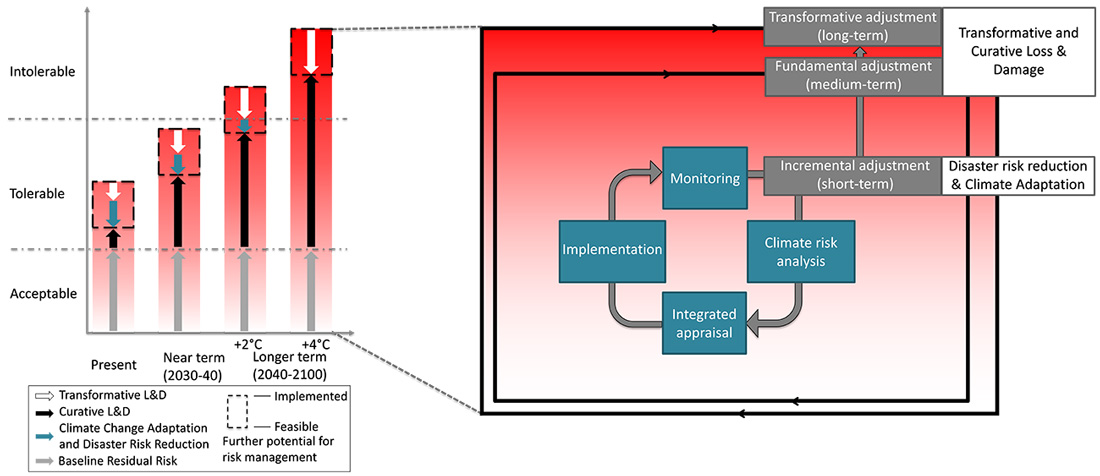
Operationalizing the Loss and Damage Mechanism
With the impacts of climate change already being felt across the globe, it is imperative to manage and avoid further irreversible loss and intolerable damage. According to IIASA researchers, adaptive learning linked to climate risk management can help overcome substantial scientific and political challenges.
Despite the Paris Agreement’s call for limiting global warming to well below 2°C above pre-industrial levels, current greenhouse gas emission reduction pledges and mitigation efforts are likely to lead to significantly higher levels of warming. This will likely intensify already significant impacts on the world’s climate. Seen from this perspective, another important outcome of the 21st Conference of the Parties to the United Nations Framework Convention on Climate Change (COP21) was the full endorsement of the Warsaw International Mechanism for Loss and Damage (L&D). To deal with these impacts, policymakers, practitioners, and members of civil society are increasingly advocating pursuing a climate risk management (CRM) strategy.
Such a strategy would entail comprehensively managing existing and future climate-related risks, including limiting their adverse impacts on the natural structure and functioning of ecosystems, and the ability of countries to pursue sustainable development pathways. This would include comprehensively reducing, preparing for, and financing climate-related risk, while tackling the underlying risk drivers, such as climate-related and socioeconomic factors.
This imperative becomes particularly challenging when focusing on those impacts that cannot, or will not, be avoided through mitigation and adaptation, thus causing irreversible loss and residual damage. Yet, the question remains how to implement action on climate-related risks today and in the future given a number of risk-analytical and sociopolitical challenges.
A number of challenges comprise the large uncertainty regarding potential future impacts of climate change at global, regional, and local levels. These include the attribution of loss and damage from specific climate-related disasters to climate change; important questions regarding distributive and compensatory justice; and dealing with non-economic losses such as impacts on ecosystems, health, security, biodiversity, and loss of cultural identity.
To address these issues, IIASA researchers from the Risk and Resilience Program suggest a transdisciplinary dynamic framework building on adaptive learning theory as applied to climate change through the concept of iterative CRM. This concept holds great potential for addressing these challenges and the remittance of L&D.
The researchers examined climate-related risks according to the Intergovernmental Panel on Climate Change’s regional assessment for the case of small-island states. The left side of the figure depicts the part of risk that can be managed by conventional climate adaptation and disaster risk reduction (blue green arrows), novel transformative loss and damage measures (white arrows), or curative L&D measures (black arrows). On the right, a framework to tackle increasing climate-related risks is shown.
According to the researchers, in the short term, the incremental adjustment process consists of a number of steps, the first of which entails monitoring existing instruments, new scientific evidence on climate change, natural hazard data, loss databases, the climate signal, and stakeholder perceptions. The second step comprises a model-based analysis of climate-related sudden onset risks and slow-onset processes, acknowledging the uncertainties associated with climate change. Step three involves the integrated appraisal of the new normal, and the modeling of results according to public and private coping capacities, taking into account economic loss and damage, non-economic impacts and risks, and justice considerations. The final step in the process entails the implementation, or update of risk management instruments according to different layers of risk, which requires decision criteria under uncertainty, bearing multiple dividends in mind. Embedding this process in a learning loop framework allows for fundamental and transformative adjustments to current, largely reactive disaster management processes, as well as employing mental and analytical models in the medium to long-term.
The study concluded that, by addressing existing climate variability and extreme weather events in the short term, a CRM-type framework for L&D could kick start the operationalization of actions on Loss and Damage and circumvent a stalemate in the political process. At the same time, by dynamically mainstreaming climate change into L&D practice as new scientific evidence emerges, the role of humans in increasing climate-related risks will not be neglected in the medium to long-term. This may send a powerful message to policymakers in the mitigation domain to work together to meet the Paris Agreement’s ambitious temperature targets.
References
[1] Schinko T & Mechler R (2017). Applying Recent Insights from Climate Risk Management to Operationalize the Loss and Damage Mechanism. Ecological Economics 136: 296-298.
Further information
Other highlights
Top image © ymphotos | Shutterstock





You must be logged in to post a comment.